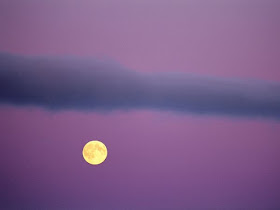A warm moon rises over Florida this February.
The latest in a series of major winter storms will dump heavy snow in areas from the Balkan Peninsula and Italy to North Africa this week. Some of these same areas have already received deep, even immobilizing, accumulations of snow following last week's series of storms.
Above: Rare snow blankets Tripoli, Libya, Monday February 6, 2012
Through Tuesday, heaviest new falls of snow will hit eastern and southern Italy to the mountains and inland valleys of Bulgaria, Serbia, Bosnia-Hercegovina, Macedonia, Kosovo and Montenegro.
By Wednesday, a fresh foot of snow will cover some of these regions. Hills above the coast in eastern Algeria and nearby Tunisia will also get new falls of snow.
While the Mediterranean storm will weaken Wednesday and Thursday, a new storm could form over the northwestern Mediterranean Sea late in the week, leading to even more snowfall.
UNUSUAL JET STREAM
CAUSES EUROPE'S EXTREME
WINTER WEATHER
Above: Italy is in the bottom center of the graphic illustrating the convoluted jet stream currently occurring over Europe.
What is causing the jet stream to occur in such labyrinthine configurations is still up for debate.
The latest predictions from the GFS and ECMWF computer weather forecasting models show the unusual jet stream pattern over Europe persisting for at least another week.
ARCTIC OSCILLATION
NORTH ATLANTIC OSCILLATION
One measure of the tendency of the jet stream to form major bulges in winter is the Arctic Oscillation (AO) Index, which has ranged between -1 and -3 over the past two weeks. A strongly negative AO Index like we're seeing this week means the winds of the jet are relatively weak, allowing it to sag southwards over Europe and allow cold air to plunge southwards. In general, a negative AO also means cold winter weather over North America, but that is not occurring this winter.
In North America, we must also pay close attention to the North Atlantic Oscillation (NAO) Index, which we can think of as the Northern Atlantic portion of the AO. Ordinarily, the AO and NAO are in phase during winter (about 80 - 90% of the time), meaning that Europe and North America experience similar winter weather. However, over the past two weeks, the NAO has been positive while the AO has been negative. The positive NAO means that jet stream winds have been strong over North America and the North Atlantic, keeping cold air bottled up to the north over Canada and the Arctic. This pattern is predicted to persist for at least another week.
We've seen many record extremes of both the positive and negative phase of the AO since 2006; read the latest post by Andrew Freedman at Climate Central to learn more.
COLD AIR ARRIVES IN THE USA THIS WEEK
A surge of cold air will dive southward late this week from the Upper Midwest to the interior mid-Atlantic and New England. While the cold won't last very long, it will feel like winter for a couple days.
The cold air won't make it all the way into Florida, according to the current forecasts. . . instead
it will be a cool and cloudy weekend with the possibility of some much-needed rain. . . before
returning to the 80°s F next week.
Is Global Warming to Blame?
This week there was a tropical system in the Gulf of Mexico. . . months earlier than 'normal.' There's been virtually no winter across the southern tier of the USA this year. . . and in Europe bitter cold and snowstorms have been the norm the past weeks.
 |
| This week parts of Florida received their first measurable rain since Halloween. |
The atmospheric flow patterns are extremely unusual this winter, and the recent weather events are symptomatic of how whacked-out our 2012 atmosphere has been. In isolation, the strange winter weather of 2011 - 2012 could be a natural, rare occurrences, but there have been too many unusual atmospheric events in the past two years for them all to be simply an unusually long run of natural extremes. Something is definitely amiss with the weather, and its clear to some scientists that the climate has shifted to a new state capable of delivering rare and unprecedented weather events frequently. Human emissions of heat-trapping gases like carbon dioxide are the most likely cause of such a shift in the weather and climate.
 |
| Paris snow |
 |
| Above and Below. . . snow cyclone blankets palm trees in Croatia. For more images of the European snows click here. |








No comments:
Post a Comment